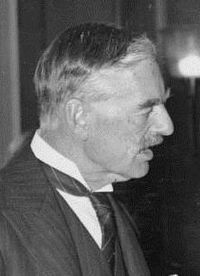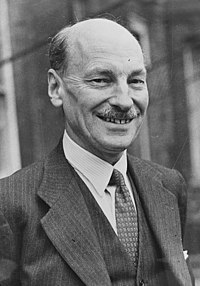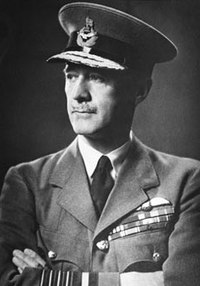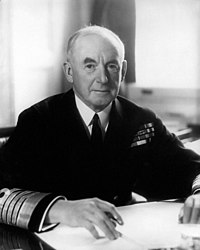Dunkirk and the British war cabinet
In late May 1940, as the Wehrmacht reached the English Channel and the British Expeditionary Force (BEF) retreated to the port of Dunkirk, tensions within the British war cabinet led to its members dividing over the question of whether to make terms with Nazi Germany or to continue hostilities. The main protagonists were the Prime Minister, Winston Churchill, and the Foreign Secretary, Lord Halifax. The dispute escalated to crisis point and threatened the continuity of the Churchill government. The retreat to Dunkirk signalled the imminent fall of France and Halifax believed the government should explore the possibility of a negotiated peace settlement. His hope was that Hitler's ally, the still-neutral Italian dictator Mussolini, would broker an agreement.
Churchill opposed negotiation and urged his colleagues to fight on. He was supported in the war cabinet by its two Labour members, Clement Attlee and Arthur Greenwood, and also by Sir Archibald Sinclair, who as leader of the Liberal Party was co-opted to the war cabinet for its meetings about proposed negotiations. Churchill's biggest problem was that he was not the leader of the Conservative Party and he needed to win the support of ex-Prime Minister Neville Chamberlain, without which he could have been forced to resign by the large Conservative majority in the House of Commons.
NB: Minutes from all war cabinet meetings in May and June 1940 are held in The National Archives, within volumes CAB–65–7 and CAB–65–13 where they are classified as WM 109 (40) to WM 188 (40). The files for 26 to 28 May are nos 139–145 (those for the two reconvened meetings are nos 140 and 145).[1][2] "WM" means War Cabinet Minutes (September 1939 to May 1945); it contrasts with "CM" which means (peacetime) Cabinet Minutes.[3]
Background
Churchill becomes Prime Minister
The 1935 UK general election was the last until 1945. It resulted in a decisive victory for the multi-party group which formed the Third National Government (1935–1937). It principally consisted of the Conservative Party, and included the remaining members of the Liberal National Party and the National Labour Committee, as well as some independent MPs. Led by Stanley Baldwin, who became Prime Minister for the third time, the government held a substantial majority (more than 200) in the House of Commons.
In May 1937, Baldwin retired and was succeeded by Neville Chamberlain as leader of the Fourth National Government (1937–1940). Chamberlain continued Baldwin's foreign policy of appeasement in the face of German, Italian and Japanese militancy. Having signed the Munich Agreement with Hitler in 1938, Chamberlain became alarmed by the dictator's continuing aggression and, in August 1939, signed the Anglo-Polish military alliance which guaranteed British support for Poland if attacked by Germany. When Germany did invade Poland, Chamberlain issued a declaration of war on 3 September 1939 and formed a war cabinet which included Winston Churchill (who had been out of office since June 1929) as First Lord of the Admiralty and Lord Halifax as Secretary of State for Foreign and Commonwealth Affairs (Foreign Secretary).
Dissatisfaction with Chamberlain's leadership became widespread in the spring of 1940 after, having mounted Operation Weserübung, German forces invaded and occupied Norway. On 7–8 May, the House of Commons debated the Norwegian campaign, which had gone badly for the Allies. The Conduct of the War debate quickly escalated into fierce criticism of the Conservative-led government's conduct of the entire war. At the end of the second day, the opposition Labour Party forced a division, which amounted to a motion of no confidence in Chamberlain's leadership. Chamberlain as Prime Minister was heavily criticised on both sides of the House by members expressing a strong desire for national unity. The Conservative rebels mostly wanted the formation of a true national government which would include the opposition Labour and Liberal parties; the Liberal Nationals having essentially become part of the Conservative Party at this point, an arrangement that would be formalised after the war ended, and the National Labour group having had minimal influence in the government since the death of former Prime Minister Ramsay MacDonald. Churchill made the closing speech in the debate and mounted a strong defence of Chamberlain, ending his speech with these words:[4]
At no time in the last war were we in greater peril than we are now, and I urge the House strongly to deal with these matters not in a precipitate vote, ill debated and on a widely discursive field, but in grave time and due time in accordance with the dignity of Parliament.
The government's notional majority was 213, but 41 members who normally supported the government voted with the Opposition, while an estimated 60 other Conservatives deliberately abstained. The government still won the vote by 281 to 200, but their majority was reduced to 81. This would normally be sustainable, but at a time of national crisis with Britain losing the war, it was a shattering blow for Chamberlain.
Next day, Thursday, 9 May, Chamberlain attempted to form a national coalition government. In talks at 10 Downing Street with Churchill and Halifax, Chamberlain indicated his willingness to resign if that was necessary for Labour to enter such a government. Labour leader Clement Attlee and his deputy Arthur Greenwood joined the meeting and, when asked if they would serve in a coalition, they said they must first consult their party's National Executive Committee, who were then in Bournemouth preparing for the annual party conference that was to start the following Monday. Even so, they indicated that it was unlikely they could serve in a government led by Chamberlain; they probably would be able to serve under another Conservative. They agreed to telephone on Friday afternoon with the result of their consultation.
Earlier on Thursday, Chamberlain had met Halifax alone and had tried to persuade him to be his successor. Halifax would probably have been the Conservative Party's preferred candidate. Halifax replied that, as a peer and not therefore a member of the Commons, he would be seriously disadvantaged as Prime Minister and would have to delegate direction of the war effort to Churchill in the Commons. He did not change his position when the same question arose at the evening meeting in which Chamberlain and Halifax were joined by Churchill and the party's Chief Whip, David Margesson. Churchill's own account of these events, written six years later, is not accurate. It describes the events of 9 May as taking place the following day, and the description of Chamberlain attempting to persuade him to agree tacitly to Halifax's appointment as Prime Minister does not tally with Halifax having expressed his reluctance to do so at the morning meeting with Chamberlain.
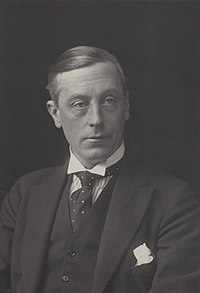
The Wehrmacht launched its blitzkrieg against western Europe on the morning of Friday, 10 May, by invading Belgium, Luxembourg and the Netherlands. Given this new crisis, Chamberlain at first declared that he would not resign, but he decided after all to await the Labour Party's decision, which he did not receive until late afternoon. Attlee telephoned Downing Street at about 4:45 pm to confirm that Labour would join a coalition government, but not under Chamberlain's leadership. Accordingly, Chamberlain went to Buckingham Palace, where he had an audience with King George VI at 6:00 pm. He tendered his resignation and, after the King asked him who should be his successor, recommended Churchill. The King sent for Churchill, who agreed to form a coalition government; the public announcement was made by Chamberlain on BBC Radio at 9:00 pm.
On Saturday, 11 May, the Labour Party agreed to join the national government under Churchill's leadership, and he was able to form his war cabinet which, at the outset, was restricted to five members, with himself as Prime Minister and Minister of Defence. Attlee relinquished his official role as Leader of the Opposition to become Lord Privy Seal (until 19 February 1942 when he was appointed Deputy Prime Minister) and Greenwood was appointed a Minister without Portfolio. The main problem for Churchill as he became Prime Minister was that he was not the leader of the Conservative Party, and so he was obliged to include Chamberlain in the war cabinet, as Lord President of the Council, and to retain Halifax as Foreign Secretary. The war cabinet was augmented by the three service ministers who attended most of its meetings; these were Churchill appointees on whose support he could generally rely. Conservative Anthony Eden became Secretary of State for War, Labour's A. V. Alexander succeeded Churchill as First Lord of the Admiralty and the leader of the Liberal Party, Sir Archibald Sinclair, became Secretary of State for Air.
War situation to Friday, 24 May
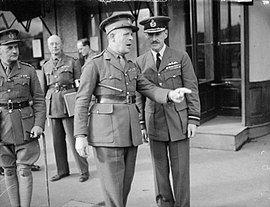
By 21 May, German tanks were approaching Boulogne-sur-Mer. In his diary entry that day, John Colville said preparations for the evacuation of the British Expeditionary Force (BEF) were being made in case of necessity.[5] An estimated 400,000 Allied servicemen, mostly of the BEF with elements of the French First Army, had retreated into the coastal area. Their hopes rested mostly on the success of the Weygand Plan, a proposed counter-offensive by themselves in conjunction with a strike from the south by the main French forces. This did not come to fruition and the BEF commander, Lord Gort, decided that evacuation was the only option. During 23 and 24 May, the Royal Navy evacuated an estimated 4,365 servicemen from Boulogne.
At a war cabinet meeting on the morning of Friday the 24th, Churchill reported that there were large numbers of French troops in Dunkirk but as yet no British servicemen other than a few specialist units. He had been advised that the port was functioning well with supplies being unloaded. There was a proposal to send Canadian troops to Dunkirk but this was pending developments in the wider theatre.
The war cabinet's interest in Italy on 24 May was limited to keeping it out of the war, or at least delaying its entry. Halifax presented a telegram from the French government which suggested an approach to the Italian dictator Mussolini by U.S. President Franklin D. Roosevelt, assuming he was willing to co-operate, for the purpose of enquiring what Mussolini's grievances were in order to have these discussed by all concerned before any resort to military action. Halifax was not confident that anything would come of the French idea but he said he would support it on condition that the approach was presented to Mussolini as a personal initiative by Roosevelt.
On the morning of 24 May, Hitler, having consulted General von Rundstedt, ordered the Panzers to halt their advance. This has been seen as one of the key decisions of the war as it gave the British extra time that they desperately needed to evacuate their servicemen from Dunkirk. Some of the German commanders disagreed with it and, a week later, General von Bock wrote in his diary that "when we do finally reach Dunkirk, the English will all be gone".[6]
Events of Saturday, 25 May
The war cabinet met in Downing Street at 11:30 am. Halifax confirmed that he had replied to the French government about their idea of persuading Roosevelt to approach Mussolini. Halifax also reported on a discussion between Sir Robert Vansittart and an unnamed Italian diplomat, although he understood the approach to be unofficial.
Boulogne surrendered on the afternoon of 25 May and the 10th Panzer Division led the German attack on Calais with support from the Luftwaffe. Dunkirk was the only available port for evacuation. With the BEF and its allies in retreat and Lord Gort warning them of impending disaster, the war cabinet had to consider the consequences of French defeat. Gort predicted the loss of all equipment and doubted that more than a small percentage of servicemen could be evacuated.
The war cabinet had already commissioned a report called British Strategy in a Certain Eventuality, drafted by the Chiefs of Staff (CoS). The report concluded that resistance to the Wehrmacht would be impossible if they gained a secure foothold in Britain: with the bulk of the army stranded in France, the home-based forces and civil defence would be inadequate. The CoS held that air defence was crucial and that the United Kingdom could not survive if Germany gained control of the air, although the Royal Navy would at least provide some breathing space. It had been calculated that Germany's air superiority was about four to one and it was vital that the British war effort must concentrate primarily on the production of fighter aircraft and crews, and the defence of those factories essential to fighter production should have priority.
The report had two main conclusions. One was that the United Kingdom could probably resist invasion if the RAF and the Royal Navy remained intact and this became a key point in Churchill's argument, against Halifax, that the country should fight on without negotiation. The other was that, ultimately, Britain could not hope to win the war without American assistance.
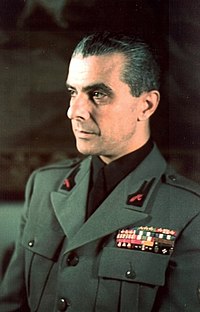
Late in the afternoon of 25 May, Halifax met Giuseppe Bastianini, the Italian ambassador to London. Halifax sent an account of the meeting to the British Ambassador in Rome, Sir Percy Loraine. It included a statement by Halifax that "matters which cause anxiety to Italy must certainly be discussed as part of the general European settlement". This was presented to the war cabinet next day.
At this stage, France and Britain wanted to keep Italy out of the war, but Halifax wanted to use Mussolini as a mediator to secure a peace that would, while giving Hitler almost complete control of continental Europe, ensure the autonomy and security of Great Britain and its empire. In his biography of Churchill, Roy Jenkins says this would have been the equivalent of a second Munich twenty months after the first.[7] In Jenkins' opinion, Halifax thought of himself as a realist but, in reality, his views chimed with his profound Christian pessimism. The key factor was that this negative outlook deprived him of Churchill's indomitable courage. Jenkins says Halifax was probably content to have England left alone, in the same way as Spain or Switzerland or Sweden. He could not understand that such a prospect was repugnant to Churchill and so conflict between the two was inevitable.[7]
At 10:00 pm, Churchill chaired a defence committee meeting at Admiralty House in which he directed that a war cabinet meeting should be held at 9:00 am the next morning. The minutes of the defence committee meeting included an order to Gort that he should march north to the coast (i.e., to Dunkirk) in battle order and to strike at all forces between himself and the sea with the assistance of General Georges Blanchard, commander of the French First Army, and the Belgians. Churchill also decreed that a plan (Operation Dynamo) should be formulated by the Royal Navy to prepare all possible means of re-embarkation from the ports and beaches. The RAF were directed to dominate the air above the area involved.[8]
War cabinet meetings – Sunday, 26 to Tuesday, 28 May
Over these three days, seven top secret ministerial meetings (including two that were adjourned and reconvened) were held at Downing Street, Admiralty House or in the Prime Minister's office at the House of Commons.[9] In the meetings, Cabinet Secretary, Sir Edward Bridges was always present when minutes were to be taken. He was sometimes assisted by other civil servants or military experts.[1][2]
The war cabinet and service ministers were usually joined by the CoS who were Admiral Sir Dudley Pound, the First Sea Lord; Air Marshal Sir Cyril Newall, the Chief of the Air Staff; and the Chief of the Imperial General Staff (CIGS).[1][2] The office of CIGS changed hands on 27 May when, as desired by Churchill, Field Marshal Sir Edmund Ironside was replaced by his deputy Field Marshal Sir John Dill. Ironside became Commander-in-Chief, Home Forces. Others who often took part included the Home Secretary, Sir John Anderson; the Permanent Under-Secretary of State for Foreign Affairs, Sir Alexander Cadogan; the Secretary of State for Dominion Affairs, Viscount Caldecote; and the Minister of Information, Duff Cooper.[1][2] At this stage of the war, Churchill's position as Prime Minister was still precarious.[10] Chamberlain remained the leader of the Conservative Party which had a massive Commons majority and Halifax was, almost certainly, the preferred establishment choice to be Chamberlain's successor. Churchill could not, therefore, afford to have both Chamberlain and Halifax aligned against him.[11] Given that the other two members of the war cabinet were long-time political opponents from the Labour Party, Churchill was by no means certain of an adequate majority within his own cabinet.[12] Attlee became a more or less silent supporter who listened rather than spoke, but Greenwood asserted himself resolutely as a supporter of Churchill's fight on policy.[12] Churchill therefore had a slender majority in the war cabinet, but so much depended on Chamberlain who was always somewhere between Churchill and Halifax. Churchill decided to invite Sinclair to attend the war cabinet after the Sunday meetings.[12] His argument was that Sinclair as leader of the Liberal Party should have a say, but in fact Sinclair was an old friend on whose support he could rely. Even with a four to two majority around the table, Churchill could not risk both Chamberlain and Halifax resigning as that would bring the Conservative majority into the equation and, almost certainly, an appeasement government like the one that would soon surrender in France.[12] He had to tread very carefully, therefore, until he could believe in Chamberlain's eventual resolve.[13]
Sunday, 26 May
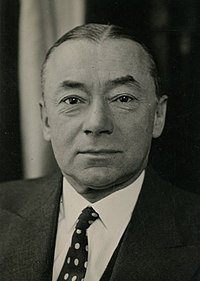
French premier Paul Reynaud was in London for much of Sunday and had a working lunch with Churchill between two war cabinet meetings, followed by a meeting with Halifax at about 3:15 pm. The war cabinet met at 9:00 am and 2:00 pm (both at Downing Street). The second one was adjourned so that, first, Halifax and then the rest of the war cabinet could meet Reynaud at Admiralty House. The war cabinet reconvened there at about 5:00 pm, following Reynaud's departure.[14]
First session
Churchill opened the meeting by briefing his colleagues on the Saturday night defence committee meeting and informing them of Reynaud's visit later on Sunday. He explained that, because of communication difficulties, the French high command had not known of Gort's decision that the BEF must retreat to Dunkirk and await evacuation. Churchill said that General Maxime Weygand was now aware and had accepted the situation. Weygand had instructed Blanchard to use his own discretion in supporting the retreat and evacuation as there was no longer any possibility of making a counter-attack to the south, especially as the French First Army had lost all its heavy guns and armoured vehicles. Churchill anticipated the total collapse of France and feared that Reynaud was coming to London to confirm it. As a result, evacuation of the BEF was now the government's first priority and, hence, the conclusions reached on Saturday night and transmitted to Gort.[15]
Churchill remained optimistic and expressed an opinion that there was "a good chance of getting off a considerable proportion of the BEF" and that he would make every endeavour to persuade Reynaud to fight on. At this time, he did not know Reynaud's plans for the day and provisionally arranged another war cabinet meeting at 2:00 pm.[16][15]
Even so, in the interest of being prepared to meet all eventualities, Churchill had asked the Chiefs of Staff (CoS) to consider the situation which would arise if the French did surrender, on the following terms of reference:[17]
In the event of France being unable to continue in the war and becoming neutral, with the Germans holding their present position, and the Belgian army being forced to capitulate after assisting the British Expeditionary Force to reach the coast; in the event of terms being offered to Britain which would place her entirely at the mercy of Germany through disarmament, cession of naval bases in the Orkneys, etc; what are the prospects of our continuing the war alone against Germany and probably Italy.
Can the Navy and the Air Force hold out reasonable hopes of preventing serious invasion, and could the forces gathered in this Island cope with raids from the air involving detachments not greater than 10,000 men; it being observed that a prolongation of British resistance might be very dangerous for Germany engaged in holding down the greater part of Europe.
Newall reminded the cabinet that the CoS had written British Strategy in a Certain Eventuality (paper no. CoS (40) 390), completed on the 25 May and now to be reviewed in the light of the new terms of reference set out by the Prime Minister.[17] This was achieved by British Strategy in the Near Future (paper no. CoS (40) 397), completed late on 26 May and presented to the war cabinet the next day.[18] It was supplemented by paper no. WCP (40) 171, written by Greenwood on the 26 May and discussing the economic aspects of the problem.[18]
There followed a brief discussion among the CoS about the defence of Calais and then, for the first time, Halifax raised the subject of Italian mediation by stating his opinion that "on the broader issue, we (the government) must face the fact that it is not so much now a question of imposing a complete defeat upon Germany but of safeguarding the independence of our own Empire and if possible that of France".[19]
He proceeded to give a report of his conversation with Bastianini who had requested a conference on the peace and security of Europe. According to Bastianini, it was Mussolini's principal wish to secure peace in Europe. Halifax had answered this by saying "we should naturally be prepared to consider any proposals which might lead to this, provided our liberty and independence were assured".[20] He confirmed that the French had been informed of the Italian approach and that Bastianini had requested a second interview that day. Churchill replied that:[20]
Peace and security might be achieved under a German domination of Europe. That we could never accept. We must ensure our complete liberty and independence. We must oppose any negotiations which might lead to a derogation of our rights and power.
Chamberlain predicted that Italy would soon issue an ultimatum to France and then come in on Germany's side. Attlee pointed out that Mussolini would be very nervous of Germany emerging as the predominant power in Europe.[20] Halifax was convinced that Great Britain was not strong enough to face Hitler alone, given that France was about to capitulate and there was no prospect of help from America.[21]
Soon after this, an aide-memoire (paper no. CoS (40) 391) was distributed by the CoS. Entitled Visit of M. Reynaud on 26th May, 1940 and signed jointly by Ironside, Newall and Pound, it anticipated the eventuality that Reynaud would announce the intention of France to make a separate peace. It firstly presented arguments to deter the French from capitulation and stressed that even if the French had decided to capitulate, "we shall continue the fight single-handed".[22] It went on to promise drastic measures, including blockade and the bombing of French cities, to be taken against France if occupied by German forces.[23] The most immediate recommendations were to demand French assistance in the evacuation of the BEF and the transfer of all French naval vessels and military aircraft to British ports and bases.[24] There was only a single mention of Italy to the effect that it would certainly exploit the situation to its advantage and satisfy its claims against France.[23]
The war cabinet expressed several views on the content of the paper. Halifax displayed a lack of understanding when he said that Great Britain could not fight alone without first establishing and then maintaining complete air superiority over Germany. Newall corrected him as the report had not said that. Instead, it was necessary to prevent Germany from achieving complete air superiority as that would enable them to invade England. Sinclair doubted Germany's ability to maintain the oil supplies necessary for a prolonged air war. Newall told Halifax that his issue was out of scope as this memoire was focused on French capitulation. Strategic questions would be discussed in the second report for which Churchill had presented terms of reference earlier.[25]
The meeting ended with the war cabinet approving the instructions given to Gort by the defence committee that he should retreat to Dunkirk in full battle order. A fleet of ships and small boats would be assembled for the evacuation. The forces in Calais were to hold out for as long as possible. The CoS would prepare a supplement to their report, based on Churchill's terms of reference.[26]
References
- ↑ 1.0 1.1 1.2 1.3 War Cabinet Minutes – May and June 1940. The Cabinet Papers, CAB–65–7 332–377. The National Archives (26–28 May 1940).
- ↑ 2.0 2.1 2.2 2.3 War Cabinet Conclusions – May and June 1940. The Cabinet Papers, CAB–65–13 282–410. The National Archives (26–28 May 1940).
- ↑ War Cabinet and Cabinet: Minutes (WM and CM Series). The National Archives.
- ↑ Conduct of the War – Churchill. Hansard, House of Commons, 5th Series, vol. 360, col. 1362 (8 May 1940).
- ↑ Colville 1985, p. 159.
- ↑ Jenkins 2002, p. 598.
- ↑ 7.0 7.1 Jenkins 2002, pp. 599–600.
- ↑ Owen 2016, p. 130.
- ↑ Owen 2016, pp. 128–129.
- ↑ Jenkins 2002, p. 599.
- ↑ Jenkins 2002, p. 602.
- ↑ 12.0 12.1 12.2 12.3 Jenkins 2002, p. 601.
- ↑ Jenkins 2002, p. 603.
- ↑ Owen 2016, pp. 132–152.
- ↑ 15.0 15.1 War Cabinet Conclusions – Confidential Annex 139. The Cabinet Papers, CAB–65–13. The National Archives (26 May 1940).
- ↑ Hastings 2009, pp. 25–26.
- ↑ 17.0 17.1 War Cabinet Conclusions – Confidential Annex 139. The Cabinet Papers, CAB–65–13. The National Archives (26 May 1940).
- ↑ 18.0 18.1 Owen 2016, p. 213.
- ↑ War Cabinet Conclusions – Confidential Annex 139. The Cabinet Papers, CAB–65–13 286–288. The National Archives (26 May 1940).
- ↑ 20.0 20.1 20.2 War Cabinet Conclusions – Confidential Annex 139. The Cabinet Papers, CAB–65–13. The National Archives (26 May 1940).
- ↑ Beevor 2012, p. 108.
- ↑ Owen 2016, p. 181.
- ↑ 23.0 23.1 Owen 2016, p. 183.
- ↑ Owen 2016, p. 185.
- ↑ War Cabinet Conclusions – Confidential Annex 139. The Cabinet Papers, CAB–65–13. The National Archives (26 May 1940).
- ↑ War Cabinet Conclusions – Confidential Annex 139. The Cabinet Papers, CAB–65–13. The National Archives (26 May 1940).
Provenance
- Some content on this page may previously have appeared on Wikipedia.
This work was originally written by me using pseudonyms and was published online 15 December 2019.
Some minor additions and amendments were made between 13 September 2020 and 18 January 2021. I think it should retain the attribution notice for the present and be classified as developing. Thanks. John (talk) 10:34, 31 May 2023 (CDT)


